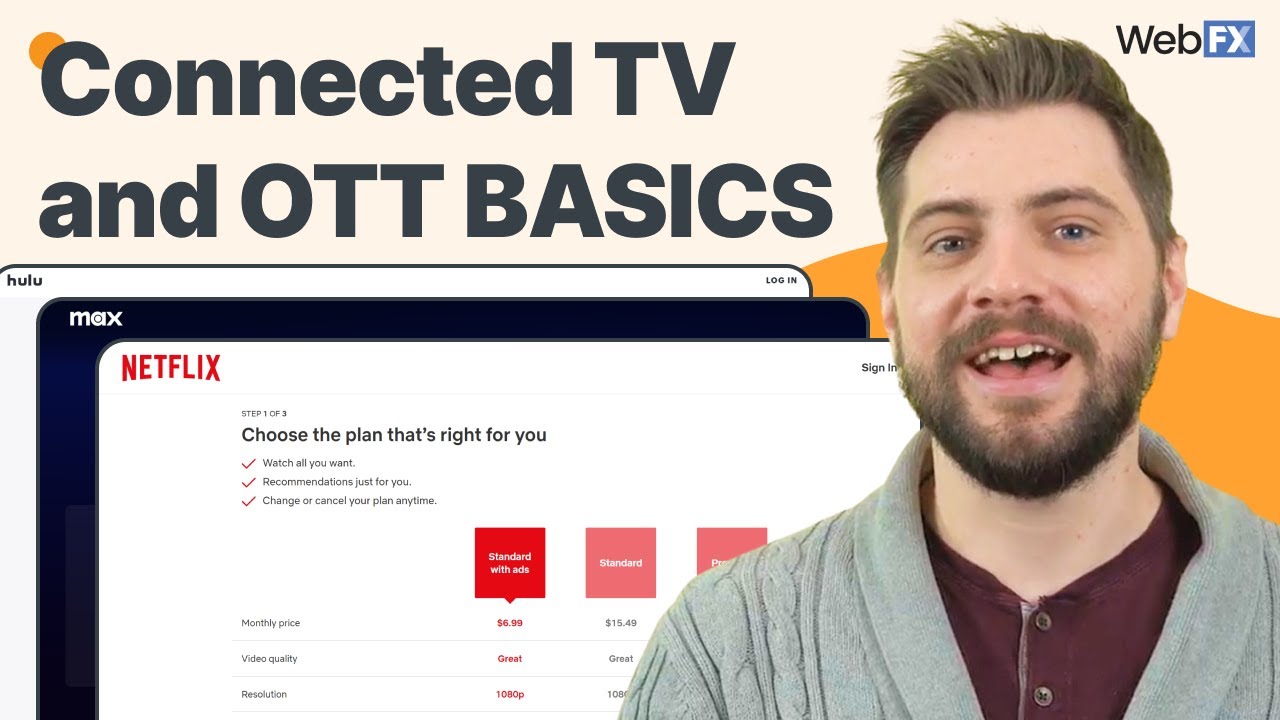In an era where traditional television is slowly losing its grip, a new player has emerged on theadvertising scene: Connected TV (CTV). With its ability to automate pricing, precisely target cord-cutters and digital content consumers, and deliver ads to streaming platforms, CTVadvertising has become a game-changer.
This shift in ad spend towards CTV not only reflects the changing preferences of consumers but also offers higher engagement and increasing popularity. Companies like The Trade Desk and Roku are at the forefront of this revolution, poised to seize the vast opportunities presented by the ever-expanding world of connected TV advertising.
So, fasten your seatbelts as we dive into this fascinating realm of digital disruption and limitless possibilities.
Table of Contents
- connected tv advertising
- Introduction: Connected Tv (Ctv) Advertising And Its Automation
- Pricing Metrics: Video Completion Rate (Vcr) And Cost Per Completed View (Cpcv)
- Ctv Ads And High Vcrs: Unskippable Ads On Streaming Services
- Measurement Factors: Brand Reach, Audience Scope, And Brand Lift
- Target Audience: Cord-Cutters And Digital Content Consumers
- Impact Of Ctv Ads: Increased Online Visits And Shopping Engagement
- Growing Popularity Of Ctv: Statistics And Dominance In Advertising
- Interactive And Shoppable Ads: Outperforming Standard Ads And Key Players In The Market
connected tv advertising
Connected TV (CTV) advertising refers to the use of automation to optimize ad prices and placements on internet-connected television devices. This form of advertising utilizes metrics like video completion rate (VCR) and cost per completed view (CPCV) to determine pricing.
CTV ads tend to have high VCRs as they cannot be skipped on many streaming services. In addition to VCR and CPCV, other measurements of CTV advertising effectiveness include brand reach, audience scope, and brand lift.
New insights from FroggyAds platform analytics.
This form of advertising specifically targets cord-cutters and digital content consumers. Studies have shown that CTV ads can increase online visits and encourage further engagement in shopping journeys.
With 87% of US TV households having at least one internet-connected TV device in 2021, CTV advertising has emerged as a dominant force, generating 51% of video ad impressions. Within CTV advertising, interactive “shoppable” ads have been on the rise and have outperformed standard ads.
The Trade Desk and Roku have been well-positioned to take advantage of this trend. Ad-funded CTV subscribers are considered more valuable than ad-free subscribers.
As traditional TV viewing hours decline and streaming hours increase, advertisers are shifting their ad spend from traditional TV to streaming platforms. These trends indicate positive prospects for The Trade Desk and Roku due to the growing popularity of CTV and the shift in advertising dollars towards streaming television.Key Points:
- Connected TV (CTV) advertising uses automation to optimize ad prices and placements on internet-connected TV devices.
- CTV ads have high video completion rates (VCRs) as they cannot be skipped on many streaming services.
- Other measurements of CTV advertising effectiveness include brand reach, audience scope, and brand lift.
- CTV ads specifically target cord-cutters and digital content consumers and have been shown to increase online visits and encourage further engagement in shopping journeys.
- CTV advertising generates 51% of video ad impressions and interactive “shoppable” ads have been on the rise within this space.
- The Trade Desk and Roku are well-positioned to take advantage of the growing popularity of CTV and the shift in advertising dollars from traditional TV to streaming platforms.
Sources
https://www.fool.com/investing/2023/07/16/surprise-connected-tv-is-dominating-global-adverti/
https://advertising.amazon.com/library/guides/connected-tv-advertising
https://multichannelmerchant.com/press-releases/lg-ad-solutions-expands-into-canadian-market-amid-growing-popularity-of-connected-tv-among-canadian-viewers/
https://smartyads.com/blog/connected-tv-advertising/
Check this out:
💡 Pro Tips:
1. Use interactive “shoppable” ads to drive engagement and increase conversion rates. These types of ads are gaining popularity and have been shown to outperform standard ads in terms of click-through rates and sales.
2. Explore partnerships with The Trade Desk and Roku to take advantage of the growing trend in connected TV advertising. These companies are well-positioned to help advertisers reach their target audience and optimize ad placements.
3. Consider targeting cord-cutters and digital content consumers with your CTV ads. These individuals are more likely to engage with and be influenced by television advertising on streaming platforms.
4. Measure the success of your CTV ads by tracking metrics like video completion rate (VCR), cost per completed view (CPCV), brand reach, audience scope, and brand lift. This data will help you optimize your ad strategy and make informed decisions for future campaigns.
5. Take advantage of the increasing popularity of connected TV advertising and shift your ad spend from traditional TV to streaming platforms. Traditional TV viewing hours are declining, while streaming hours are on the rise, making CTV a more effective and efficient advertising channel.
Introduction: Connected Tv (Ctv) Advertising And Its Automation
Connected TV (CTV) advertising has revolutionized the way advertisers connect with their target audience. With the rise of streaming services and internet-connected TV devices, CTV advertising has become a powerful tool for brands to engage consumers in a more targeted and personalized way.
One of the key advantages of CTV advertising is its use of automation, which allows for optimized ad prices and placements. This means that advertisers can maximize their return on investment by reaching the right audience at the right time.
Pricing Metrics: Video Completion Rate (Vcr) And Cost Per Completed View (Cpcv)
In CTV advertising, pricing is often based on metrics such as the Video Completion Rate (VCR) and Cost per Completed View (CPCV). The VCR measures the percentage of viewers who watch an ad in its entirety, while the CPCV calculates the cost of each completed view.
CTV ads tend to have high VCRs as they cannot be skipped on many streaming services. This guarantees that advertisers get their message across to a captive audience, resulting in higher engagement and brand recall.
Ctv Ads And High Vcrs: Unskippable Ads On Streaming Services
One of the reasons CTV ads have such high VCRs is that they are often unskippable on many popular streaming services. Unlike traditional television ads, which can be fast-forwarded or skipped entirely, CTV ads command the viewer’s full attention.
This makes them highly effective in conveying brand messages and driving brand awareness. With the rising popularity of streaming services among consumers, CTV ads have emerged as a preferred advertising medium for marketers looking to reach cord-cutters and digital content consumers.
Measurement Factors: Brand Reach, Audience Scope, And Brand Lift
When measuring the success of CTV advertising campaigns, several factors come into play. These include brand reach, audience scope, and brand lift.
Brand reach refers to the number of unique viewers who have been exposed to an ad. Audience scope evaluates the demographic and behavioral characteristics of the viewers, allowing advertisers to target specific segments effectively.
Brand lift measures the impact of CTV ads on key brand metrics such as awareness, consideration, and purchase intent. By analyzing these measurement factors, advertisers can refine their CTV strategies and optimize their campaigns for better results.
Target Audience: Cord-Cutters And Digital Content Consumers
CTV ads specifically target cord-cutters and digital content consumers. Cord-cutters are individuals who have chosen to cancel their traditional cable or satellite TV subscriptions in favor of streaming services.
These consumers have embraced the convenience and flexibility of streaming, making them an attractive audience for advertisers. Digital content consumers, on the other hand, encompass a broader group of individuals who consume content through various digital platforms.
These individuals often have a higher affinity for online shopping and are more likely to engage with CTV ads.
Impact Of Ctv Ads: Increased Online Visits And Shopping Engagement
CTV ads have a profound impact on consumer behavior, leading to increased online visits and engagement in shopping journeys. With the rise of interactive and shoppable ads, viewers can directly engage with the advertised products or services, leading to higher conversion rates.
Furthermore, CTV ads can integrate seamlessly with other digital marketing channels, allowing advertisers to create a cohesive and immersive brand experience across multiple touchpoints. This integration drives consumers to further explore a brand’s offerings and fosters long-term customer loyalty.
Growing Popularity Of Ctv: Statistics And Dominance In Advertising
The popularity of CTV advertising is on the rise, with statistics showing its dominance in the advertising landscape. In 2021, a staggering 87% of US TV households had at least one internet-connected TV device, highlighting the widespread adoption of CTV.
Furthermore, CTV accounted for an impressive 51% of video ad impressions, signaling its significant share in the advertising market. As traditional TV viewership declines and streaming hours increase, advertisers are shifting their ad spend from traditional TV to streaming platforms, further fueling the growth of CTV advertising.
Interactive And Shoppable Ads: Outperforming Standard Ads And Key Players In The Market
A notable trend in the CTV advertising space is the rise of interactive and shoppable ads, which have proven to outperform standard ads. Interactive ads allow viewers to engage with the content by clicking or interacting with specific elements, creating a more immersive and engaging experience.
Shoppable ads take it a step further by allowing viewers to directly purchase products or services without leaving the streaming platform. Key players in the market, such as The Trade Desk and Roku, have positioned themselves to take advantage of this trend, offering advertisers robust tools and capabilities to leverage the power of interactive and shoppable ads.
Overall, the increasing popularity of CTV and the shift in advertising dollars towards streaming television indicate positive indicators for both The Trade Desk and Roku. With their innovative platforms and emphasis on targeted engagement, these companies are well-positioned to capitalize on the growing opportunities in the CTV advertising landscape.
As brands continue to recognize the benefits of CTV advertising, it is clear that unlocking the power of targeted engagement is the key to driving success in the digital advertising realm.
Performance Marketing Tips • Self-Serve DSP Platform • Programmatic Advertising • Native Ad Network • Buy Traffic












